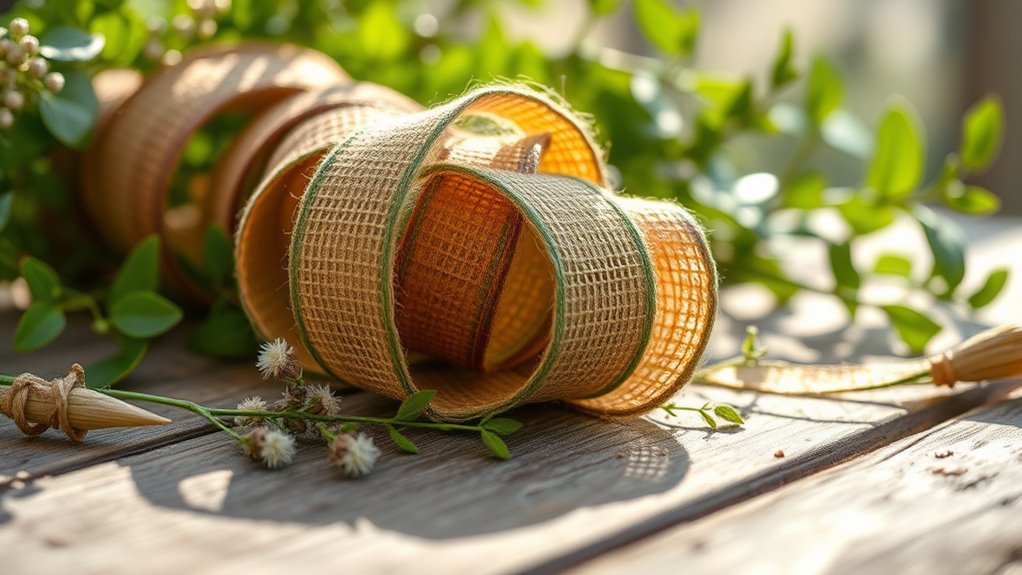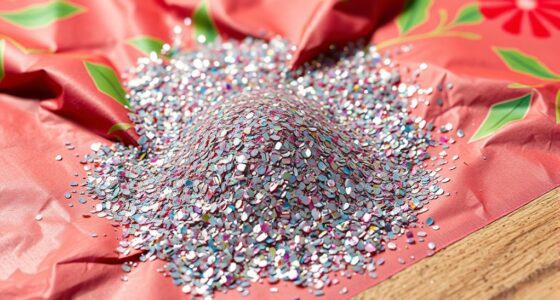For sustainable, compostable ribbon options, consider natural fiber ribbons made from cotton, jute, or hemp—these are biodegradable and support cultural traditions. You can also use paper-based ribbons or twine crafted from recycled or responsibly sourced paper, which decompose easily. Plant-based bioplastics like cornstarch or sugarcane ribbons are designed to break down quickly. Edible ribbons made from fruit leather or rice paper offer safe, biodegradable alternatives. Continue exploring how these eco-friendly choices can enhance your projects effortlessly.
Key Takeaways
- Choose natural fiber ribbons made from cotton, jute, or hemp, which are biodegradable and decompose easily in compost.
- Opt for paper-based ribbons and twine from recycled or responsibly sourced paper that naturally break down in composting environments.
- Use plant-based bioplastics or compostable plastics derived from renewable resources like cornstarch or sugarcane for eco-friendly disposal.
- Incorporate edible, food-grade ribbons made from rice paper, fruit leathers, or flavored seaweed, which are safe to compost after use.
- Add natural decorations such as dried flowers, seed pods, or herbs to enhance eco-friendly aesthetics and support composting efforts.
Natural Fiber Ribbons From Cotton, Jute, and Hemp
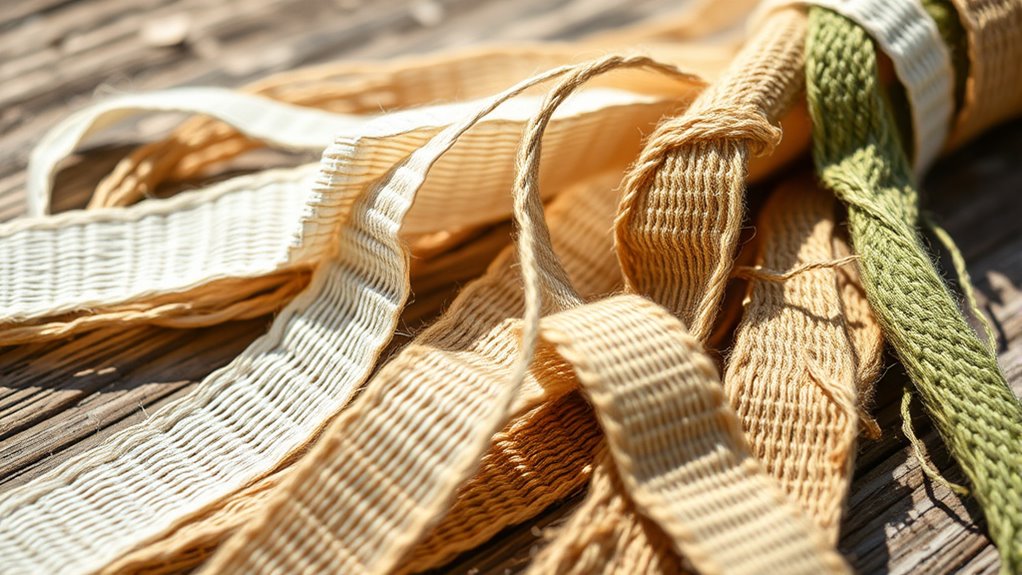
Have you ever considered replacing synthetic ribbons with natural fiber options? Cotton, jute, and hemp ribbons are eco-friendly choices that can enhance your projects. These fibers lend themselves well to various dyeing techniques, allowing you to create vibrant, personalized colors without harmful chemicals. Beyond their practicality, natural fibers often hold cultural significance; for example, hemp has been valued in traditional ceremonies, while jute is integral to craft practices in many regions. Using these materials not only reduces plastic waste but also connects you to age-old traditions. Their biodegradable nature means they decompose naturally, making them an excellent sustainable alternative. Opting for natural fiber ribbons supports environmentally conscious practices while adding a touch of cultural richness to your creations. Understanding biodegradable materials helps you make more sustainable choices in crafting, and exploring wealth of eco-friendly options can inspire further sustainable craft projects.
Biodegradable Paper-based Ribbons and Twine

Are you looking for an eco-friendly alternative to traditional ribbon and twine? Biodegradable paper-based ribbons and twine offer a sustainable, plastic-free option that breaks down naturally in compost. Unlike synthetic alternatives, these ribbons are made from recycled or responsibly sourced paper, reducing environmental impact. They’re perfect for gift wrapping, decorations, and packaging, providing a rustic, charming look. Plus, their compostability guarantees they won’t contribute to landfill waste. Here’s a comparison to help you choose:
| Feature | Paper-based Ribbons | Synthetic Alternatives | Plastic-Free Options |
|---|---|---|---|
| Compostability | Yes | No | Yes |
| Material | Recycled paper | Nylon, polyester | Natural fibers, paper |
| Environmental Impact | Low | High | Low |
| Durability | Moderate | High | Moderate |
| Appearance | Rustic, natural | Smooth, glossy | Varied, eco-friendly look |
Choosing biodegradable options also aligns with sustainable manufacturing practices, promoting a healthier planet. Incorporating these biodegradable options into your decluttering process can help reduce waste and support mindful consumption habits. Additionally, opting for biodegradable materials can enhance your commitment to environmental preservation.
Plant-Based Bioplastics and Compostable Plastics

Plant-based bioplastics and compostable plastics offer sustainable alternatives to conventional petroleum-based plastics, addressing environmental concerns without sacrificing functionality. Unlike traditional plastics made from synthetic polymers derived from fossil fuels, these bioplastics are produced from renewable resources like cornstarch, sugarcane, or potato starch. They decompose more quickly in composting environments, helping reduce plastic pollution. While they share some properties with synthetic polymers, bioplastics are designed to break down with minimal environmental impact. Using these materials can markedly lower your contribution to plastic pollution, especially in applications like ribbons and packaging. By choosing plant-based and compostable plastics, you support a circular economy and help lessen reliance on fossil fuels, making your eco-friendly choices more effective. Additionally, materials designed for compostability are often tested to meet specific standards, ensuring they break down properly in designated environments. Incorporating certified compostable plastics can further ensure your products meet environmental expectations and truly contribute to waste reduction efforts. Opting for these renewable resources helps promote sustainable manufacturing practices and reduces dependency on non-renewable fossil fuels.
Edible and Food-Grade Ribbon Options
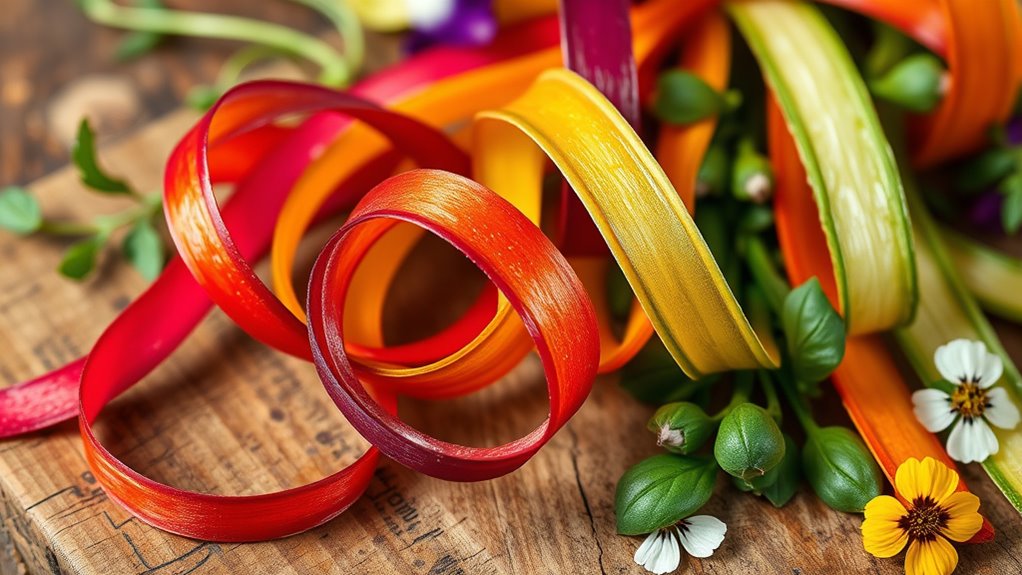
Edible and food-grade ribbons offer a sustainable and creative alternative for packaging and decoration. You should explore different edible ribbon varieties and consider safe, food-grade materials to guarantee they’re suitable for your needs. Keep safety tips in mind to make sure your edible ribbons are both attractive and safe to consume. For instance, using food-safe materials ensures the ribbons are durable and non-toxic during handling and consumption. Additionally, selecting materials that align with keto diet principles can help maintain dietary preferences while embracing eco-friendly options. Incorporating mindfulness techniques, such as visualization, can also enhance your focus when choosing or creating these eco-conscious decorations.
Edible Ribbon Varieties
Have you ever considered using edible ribbons as a sustainable alternative to traditional packaging or decoration? Edible ribbon varieties are versatile options that add charm to garden decor and gift wrapping alike. Made from ingredients like fruit leathers, rice paper, or flavored seaweed sheets, these ribbons are not only visually appealing but safe to consume. They can be shaped into bows or loops, enhancing the presentation of gifts or outdoor displays without creating waste. Since they’re food-grade, they meet safety standards and are easy to incorporate into eco-friendly projects. Using edible ribbons reduces reliance on plastic or synthetic materials, making your decorations more sustainable and compostable. Additionally, the concept of wealth transformation and strategies highlights how innovative approaches can lead to increased value, much like how choosing sustainable materials can enhance the appeal and longevity of your decorations. Plus, they offer a fun, edible twist that’s sure to delight recipients and nature lovers alike. Incorporating environmentally friendly materials into your projects can further amplify their positive impact on the environment. Embracing such sustainable innovations can inspire others to rethink traditional wasteful practices and promote a greener lifestyle.
Food-Grade Material Options
What materials guarantee that ribbons are both safe to eat and environmentally friendly? Food-grade options typically avoid synthetic polymers and chemical coatings, ensuring they’re non-toxic and biodegradable. Natural materials like rice paper, cellulose, and edible films are excellent choices because they don’t contain harmful additives. Some food-grade ribbons are made from plant-based fibers treated with food-safe coatings, avoiding synthetic polymers that can persist in the environment. Chemical coatings used in non-edible ribbons often contain preservatives or finishes that aren’t suitable for consumption or composting. By choosing ribbons made from natural, edible materials without synthetic polymers or chemical coatings, you assure your packaging is safe, eco-friendly, and compostable, aligning with sustainable practices and supporting the health of both your products and the planet. Additionally, incorporating vibrational energy awareness can enhance your eco-conscious choices by aligning your intentions with positive environmental impact. Recognizing biodegradability as a key factor can help you select the most environmentally responsible options, especially when considering natural decomposition processes that ensure minimal environmental footprint.
Safety and Usage Tips
Choosing the right food-grade ribbons guarantees your packaging remains safe for consumers and environmentally responsible. Always check for chemical safety, ensuring the materials are free from harmful substances. Consider allergy considerations by selecting ribbons made from natural ingredients that won’t trigger sensitivities. Read labels carefully to confirm the ribbon’s edible quality and safety standards. Keep in mind that some edible ribbons may still pose allergy risks, so inform consumers accordingly. Use the table below to compare options:
| Feature | Important Consideration |
|---|---|
| Chemical safety | Verify non-toxic, food-safe materials |
| Allergy considerations | Avoid common allergens like nuts or gluten |
| Usage tips | Follow proper storage and handling |
Additionally, understanding color accuracy can help ensure your ribbons look appealing and true to their intended appearance.
Recyclable and Reusable Fabric Ribbons
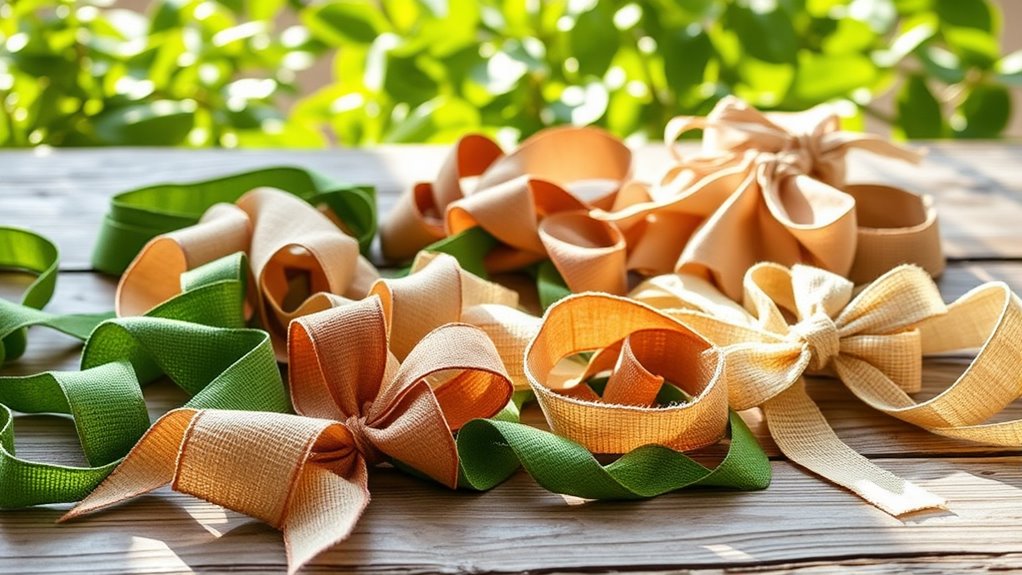
Recyclable and reusable fabric ribbons offer a sustainable alternative to traditional plastic or paper options, making them an eco-friendly choice for gift wrapping and decoration. These ribbons are often made from natural or recycled fibers, reducing waste and environmental impact. Unlike synthetic fibers, which can take centuries to decompose, many fabric ribbons can be washed and reused multiple times. Some feature metallic finishes, giving them a stylish, shiny look without relying on non-recyclable materials. By choosing these fabric ribbons, you minimize waste and extend their life through reuse. Their durability and versatility make them ideal for eco-conscious gift wrapping, décor, or craft projects. Plus, they add a touch of elegance while supporting sustainable practices in your celebrations.
Creative Alternatives: Using Natural Elements for Decoration

Building on the idea of eco-friendly decorations, incorporating natural elements into your designs offers a beautiful, sustainable alternative to manufactured ribbons. Instead of synthetic alternatives or plastic substitutes, consider using dried flowers, seed pods, or braided straw for embellishments. These natural elements not only add texture and visual interest but also decompose effortlessly, reducing waste. You can weave greenery or herbs into bows or tie bundles of cinnamon sticks for aromatic accents. Using items from nature assures your decorations are biodegradable and compost-friendly. Additionally, understanding ethical hacking principles can help you safeguard your eco-friendly projects from cyber threats. Incorporating composting techniques ensures your natural decorations break down efficiently and enrich your soil. Using items from nature ensures your decorations are biodegradable and compost-friendly. This approach allows you to create stunning, eco-conscious displays that celebrate the environment without relying on synthetic or plastic materials. Embracing natural elements makes your decor both meaningful and environmentally responsible, and selecting materials with biodegradability in mind will further enhance your sustainability efforts.
Frequently Asked Questions
How Long Do Compostable Ribbons Take to Decompose Naturally?
You might wonder about the decomposition timeline for compostable ribbons. Typically, these ribbons break down within a few months, depending on factors like temperature, moisture, and microbial activity. This quick decomposition reduces your environmental impact by avoiding long-lasting waste. Using compostable ribbons helps you contribute to a healthier planet, as they naturally return to the soil without leaving harmful residues, making them an eco-friendly choice for sustainable gifting or packaging.
Are There Any Health Risks Associated With Using Edible Ribbons?
Think of edible ribbons as a sweet promise, but you might wonder about health concerns. While they’re generally safe, some could carry toxin exposure if not made with food-grade ingredients. You should check labels carefully to avoid potential risks, especially if you or others have allergies. Being cautious guarantees you enjoy their charm without risking health concerns—like opening a gift with a hidden surprise.
Can Natural Fiber Ribbons Be Dyed Without Affecting Compostability?
You can dye natural fiber ribbons without harming their compostability by using natural dyeing techniques. By opting for natural dyes derived from plants, roots, or minerals, you avoid synthetic chemicals that could interfere with composting. Fiber blending can also help, as combining fibers may enhance dye absorption and durability. Just guarantee the dyes are eco-friendly and free from toxic additives, so your ribbons remain compostable and environmentally safe.
What Are the Best Methods to Store Biodegradable Ribbons?
When storing biodegradable ribbons, you should follow simple storage tips to keep them in good condition. Keep them in a cool, dry place away from direct sunlight to prevent deterioration. Use airtight containers or sealed bags to protect against moisture and pests. Proper preservation techniques ensure your ribbons stay flexible and intact until you’re ready to use them. Avoid exposure to extreme temperatures and humidity for ideal longevity and performance.
How Do I Compost Bioplastics Safely at Home?
Imagine your garden as a quiet symphony, where bioplastics play a gentle note. To compost bioplastics safely at home, you need to understand bioplastic breakdown and follow simple composting tips. Start by chopping bioplastics into smaller pieces, mix them into rich compost, and keep the moisture balanced. With patience, these materials will transform into nourishing humus, blending seamlessly into nature’s melody.
Conclusion
By choosing sustainable ribbon alternatives, you not only reduce waste but also make eco-friendly choices that feel surprisingly natural. It’s funny how, just when you start exploring compostable options, you realize how many beautiful, biodegradable materials are right at your fingertips. Whether it’s cotton, jute, or edible ribbons, these eco-conscious choices become part of your everyday life—and maybe even spark a new appreciation for the simple, sustainable things around you.
